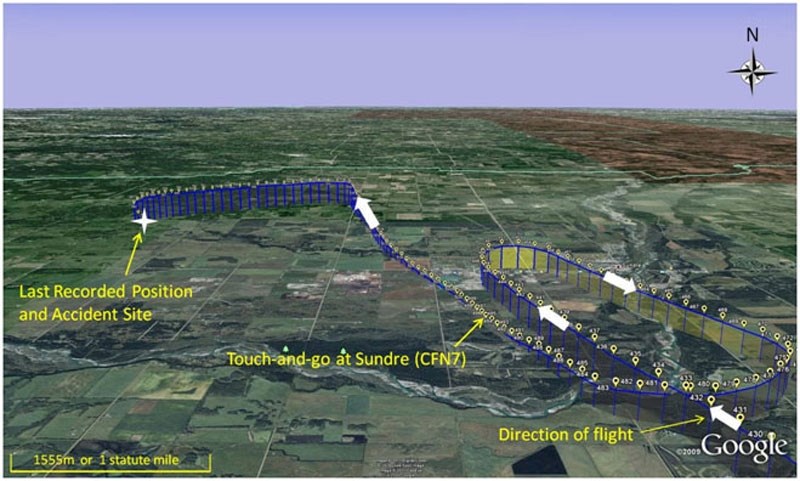The Transportation Safety Board of Canada investigation into a plane crash that killed three men outside Sundre on September 24, 2010 has failed to determine exactly why the Cirrus SR22 aircraft went into a spin seconds before impact.
ìUnfortunately there are some questions that we will never be able to answer,î said John Pearson, TSBC senior investigator.
Chuck Matson, 51, Stephen Brosseau, 43, and 42-year-old James DuBarry died when their aircraft slammed into a farm field eight kilometres northwest of Sundre.
Released last week, the 12-page final report into the crash highlights three principal findings as to the ìcauses and contributing factorsî of the accident:
1. For undetermined reasons, the aircraft decelerated to the point of aerodynamic stall, followed by entry into a spin.
2. The aircraft recovered from the initial spin entry and entered a spiral dive from which recovery was not accomplished before ground impact.
3. For undetermined reasons, the parachute system was not activated after the aircraft departed controlled flight.
The initial deceleration may have been tied to the fact the flight was made to give Brosseau and the other man a chance to familiarize themselves with the aircraft, which they had just purchased, investigators said.
Although it was determined that Matson was in the left front seat ñ the position typically occupied by the primary pilot ñ the investigation could not determine who was in the right front seat, which also has flight controls.
ìSince the purpose of the flight was likely to familiarize the new owners with their aircraft, it is reasonable to assume that the right seat occupant was allowed to manipulate the flight controls,î the report states.
ìThe passengers, who were also pilots, were relatively unfamiliar with the aircraft control and display systems, and had little or no experience in flying from the right seat.
ìSince the style and placement of the side-stick flight control and flight instruments were different from what either of the prospective owners were accustomed to, maintaining precise control of the aircraft from the right seat would have presented a challenge.î
Investigators determined that the behaviour of the plane moments before the crash was consistent with a pilot ìexperiencing difficulty in maintaining precise control.î
ìThis would suggest that one of the purchasers, occupying the right seat, was in control at the time. The gradual deceleration while maintaining a constant altitude is consistent with engaging in slow flight. With the airspeed deteriorating to stall speed, mishandling of the controls could result in a wing dropping and a departure from controlled flight.î
Investigators found no outstanding medical issues with any of the occupants.
ìPilot incapacitation could neither be proven nor eliminated due to the limitations of the autopsy processes,î the report states.
The aircraft's parachute system, designed to lower the entire plane down in the event of an emergency, did not deploy prior to the crash.
However, it appeared from an examination of the crash scene that the parachute did deploy sometime after impact, investigators said.



